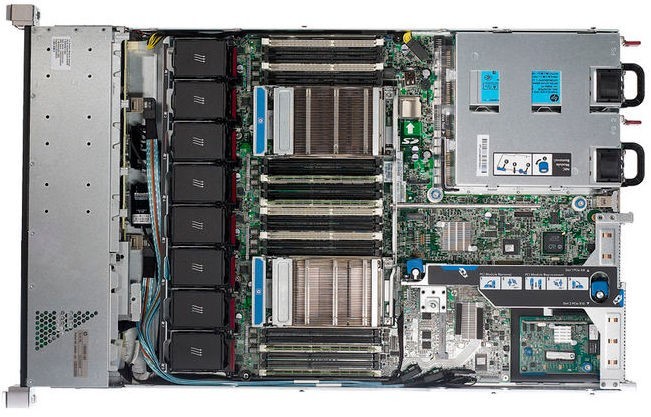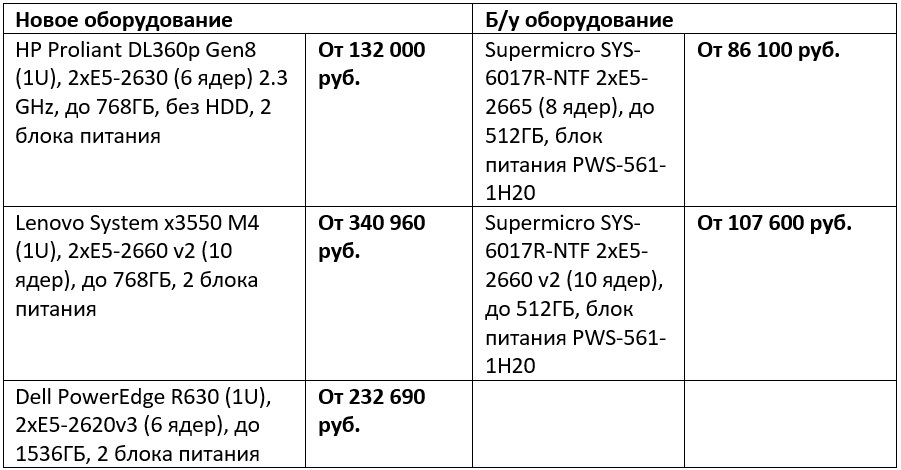How to choose the best server solution and not make a mistake
If you have already made a strategic choice in favor of buying a server and creating your own IT infrastructure, then your next step will be to choose a specific server platform.
We have already told how to choose a server for a small company , and this article is its logical continuation, from which you will learn how to choose the right server platform for you, how it will affect your business and why this choice is important.

You should read this manual because:
- You will be able to choose a server that will not only cope with its tasks, but will also not create excessive performance and unnecessary hardware ownership costs.
- You not only optimize your costs today, but also ensure maximum return on investment and protect your IT infrastructure in the future.
A choice of three segments: Enterprise, SMB, SoHo
Today, the system of separation of server equipment for its quality, reliability and purpose into several segments is quite widespread. Best of all, it can be formulated as follows:

SoHo equipment is simpler, less expensive, and more suitable for simple tasks. As a rule, a productive and reliable IT infrastructure is not built from SoHo equipment, as it is better suited for home and office networks designed for small loads and capable of combining only a small number of hosts.
On the other hand, the reality is that sometimes it will be more profitable for a small enterprise to use a small amount of equipment at the Enterprise level with all its high resiliency, sufficient scalability and an excellent level of service / technical support, while some relatively large enterprises will be able to do without saving and SMB - because the total cost of ownership of equipment and software is not limited only to their purchase. It also includes the maintenance, maintenance and repair of equipment, plus, of course, losses from downtime. Well, huge corporations can create their own server and even data centers, combining equipment of all levels in their infrastructure.
To decide on the choice of equipment you need:
- Assess the risks. Your company does not exceed the size of the level corresponding to SoHo, but its turnover may well correspond to the level of SMB or Enterprise. How much will the downtime of the equipment you buy cost? Wouldn't it be more forward-looking to acquire sufficient resiliency?
- Think about tomorrow. Even if today you are completely satisfied with something from the initial segment, then tomorrow your enterprise can grow, after which the problem of expanding the IT infrastructure and proper management of the entire server park will immediately arise.
Below we will also discuss what happens if we combine equipment manufacturers, as well as how to make our own infrastructure more sustainable. However, whatever path you choose - never forget about scalability.

"Big Three"
The main representatives of the segment are the well-known “Big Three”: Hewlett-Packard, IBM (Lenovo) and Dell, offering high-end equipment designed to ensure high performance, as well as ease of upgrade and system management in general, but not without drawbacks. Their main drawback, of course, is the cost of acquiring this equipment, since the creation of such a perfect technology is far from cheap.
Each vendor of Troika tries to create the most fault-tolerant and reliable system, thinking through every detail and detail. As a rule, these manufacturers strictly regulate the components supported (and accordingly tested) with their hardware, simultaneously distributing them in the “channel”. Therefore, each manufacturer has a whole ecosystem of its own software and hardware, the arbitrary replacement of which may entail a loss in performance. But these restrictions are not laid at the level of iron.
It is also worth remembering that one of the main advantages of these vendors is the service provided (HP Care Pack, ProSupport Dell and IBM ServicePac). This is a very expensive service, available in several variations, some of which can increase the cost of equipment by one and a half to two times. With such costs, technical support specialists will be available 24/7 and their response time will not exceed several hours.
But technical support may well refuse to provide assistance or a guarantee if you go there with a system in which components not approved by the manufacturer will be installed. This reduces the sense of saving to nothing.
Convenience and simplicity in managing your server fleet can also be achieved if you build the entire infrastructure on the same manufacturer's platform.
In addition to all the above, expensive, powerful (and not always sufficiently flexible) equipment from the Enterprise segment can provide its owner with redundant fault tolerance, performance, and extra services.
And, of course, you should understand that any servers fail and are often subject to unpredictable problems with software compatibility and updating. It’s just that the Enterprise segment is less affected and tries to provide all the necessary resources to solve the problem as quickly as possible.
')
Choice from "Troika"
The competitive struggle between the members of the Big Three is a very old high-tech rivalry. The administration of any of these giants is practically a separate profession, therefore, it is rather difficult to compare their strengths and weaknesses. In general, they look like this:


In order not only in words, but also in practice to demonstrate these differences, let's consider several powerful servers from Troika in the 1U form factor, ideal for virtualization (and their used analogs - where it is possible to pick them up):

Virtualization makes the most demands on the processing power of the server, and the presence in the lineup of one or another server manufacturer for virtualization is quite revealing. The most elegant solution, powerful and inexpensive, offers HP, although the Dell server is capable of more, but it costs one and a half times more. The most expensive is the Lenovo server - it has fewer slots for RAM, but powerful enough processors.
SMB or Enterprise?
Supermicro - Niche Player
The main and most popular player in the SMB segment is Supermicro, which actually managed to implement a versatile designer that is compatible with a wide variety of components. You can build anything from anything on this platform, and the claim that its servers are less reliable and fail more often than Troika equipment always comes up with a lack of statistics and an objection from the army of satisfied brand users. So what exactly at the mention of Supermicro raises the question - is it SMB or Enterprise? So far, there are more voices in favor of the first option, but maybe this is just the power of inertia of thinking?
Supermicro also has its own server management interface in the absence of physical access to them - IPMI, which, although it cannot boast the same rich functionality as Troika, can show system logs, adjust the fan speed and provide access to iKVM Console Redirection.
Yes, there is no full support for remote firmware of some components on Supermicro platforms (for example, a discrete Raid controller or a network card). Too large amounts of different hardware can be used in it, and it is impossible to calculate all the situations of a complete set, as is done in the Enterprise segment. But this is exactly what provides the flexibility of the platform, which the Troika lacks.
However, more than once we have encountered situations where some separate parts of the platform — power supplies, ventilation, backplane — have been let down by Supermicro. To achieve sufficient resiliency of the system exclusively on Supermicro, the infrastructure can be backed up by duplicating each server, and in total it may turn out to be cheaper than acquiring a similar platform from Troika. It is fair to say that this will double the cost of cooling, power supply and their maintenance as a whole.
Elementary logic suggests an obvious solution: important / critical services for a company are deployed on enterprise (enterprise) equipment (servers), less important - on an SMB-level servers. Here, of course, everything should depend on the specific situation, and your decision should be based on the possibilities of your budget and risk assessment.
Another frequent life hacking, which has no drawbacks of double power and cooling, is to use Supermicro spare spare servers for cold replacement, just remove not a separate power supply unit / disk, but a whole rack at a time. Such a trick with the equipment from Troika hardly makes sense.
Separately, it is worth saying a few words about Supermicro technical support. The company has no representative office in Russia, and technical support is not in contact with the end user. Do not be surprised if you have to wait for a response within a week or two, and your supplier will fulfill the warranty with a long delay.

Again referring to specific examples, recall the powerful virtualization server build Supermicro Team Server R1-E54 (1U), 2xE5-4600 v2 (12 cores), up to 1024GB, 1400W power supply. It costs from 167,000 rubles, but at the same time in terms of power and potential it freely competes with the “Big Three”.
True, buying such a server in a ZIP will already be expensive. But the above-mentioned model of a used server for the same money can be bought one to work and one reserve - their power is comparable.
Fujitsu - its among strangers, a stranger among its
Considerable popularity in the domestic market today managed to dial the servers of the Japanese company Fujitsu, which is engaged not only in the production of server hardware, but also the creation of supercomputers.
It is not yet as well known as Troika or Supermicro, but its representatives claim that it ranks fourth in the global server market and first in Japanese (although according to some sources, NEC is in the local market in 13 years Fujitsu in the Japanese x86 server market was 5% less than NEC). Fujitsu is eager to join the “Big Three” by all available means, trying not to yield to either the resiliency of the equipment, nor to the scalability, nor to the service.
Unlike SM, Futjitsu has a representative office in Russia and is trying to create a service as close as possible to the proposed Troika Support Pack, which in its expanded form also includes round-the-clock technical support, quick response, calling specialists and extending the warranty period. In addition, the company is also ready to conclude with the Solution Contract clients, providing support and customization of software in accordance with the needs of a specific project, monitoring equipment by the company's specialists and recommendations for expanding or improving infrastructure.

Powerful modern virtualization server Fujitsu Primergy RX2530M1 (1U), 2xE5-2600v3 (6 cores), up to 1536GB, 2 power supplies with a capacity of 450 W / 800 W cost only 112,694 rubles. Bypasses in the possibilities of RAM the corresponding Supermicro assemblies, it may be a little “sagging” in the processor power, but it is relatively cheap, while the manufacturer claims that the Troika level is fault tolerant.
Unfortunately, the brand’s reputation in this country is simply not there, so it’s difficult to determine its position between the Troika, for which it supposedly follows the whole world, and Supermicro, which is supported by its whole army of fans. Maybe someone will see an opportunity for themselves when choosing this platform to save quite well on agreements with the company about discounts, but this will have to rely on their own business acumen.
Summarizing
So, if for you the key parameter in choosing is fault tolerance, if you already understand now that the system will have to be scaled accurately, and the problems that have arisen solved as quickly as possible, choose from the Big Three. Most likely, the least cost will be from Lenovo, HP probably will find a good combination of cost and performance (and a hard limit on hardware) - however, it’s already necessary to proceed from specific tasks.
If you want to save money and get powerful productive equipment, you should think about a system based on the Supermicro platform, however, in this case, you will be faced with the task (quite, as we showed, solved) of ensuring fault tolerance. The same can be said if you do not have enough funding for Troika - in which case, you can think of alternative platforms that are less represented in our country but are valued in the world - for example, Fujitsu.
And what advantages and disadvantages of the equipment of these vendors did you encounter?
Source: https://habr.com/ru/post/324412/
All Articles